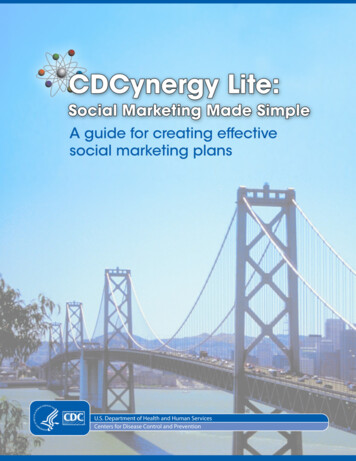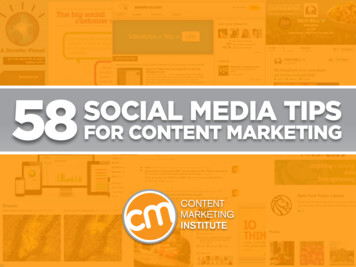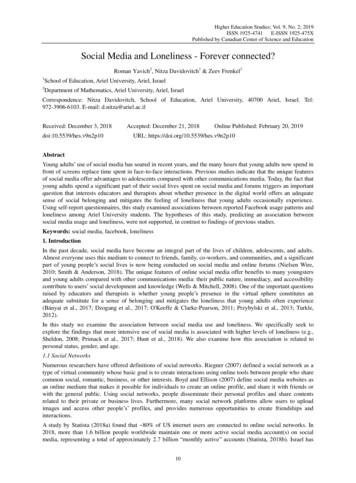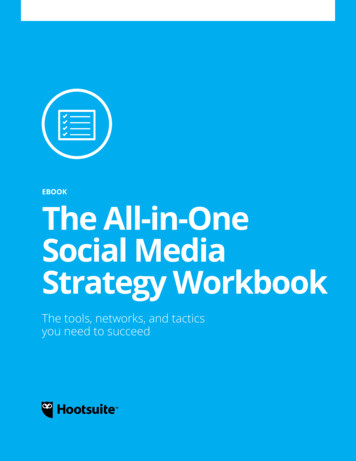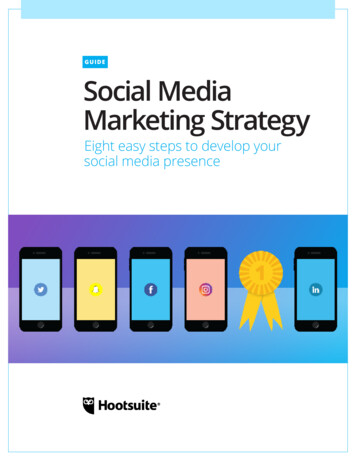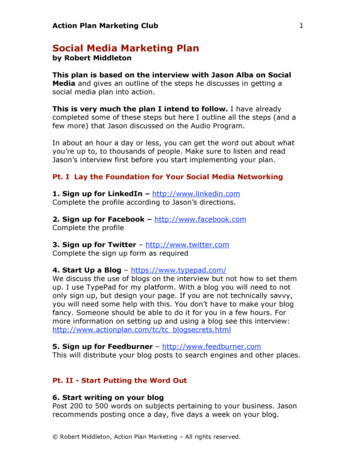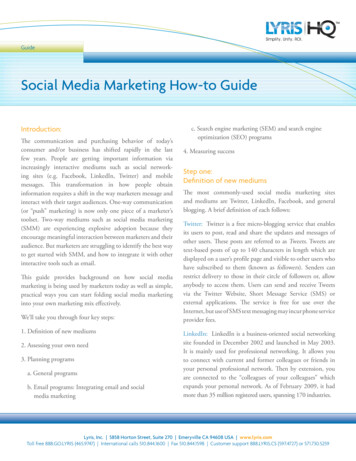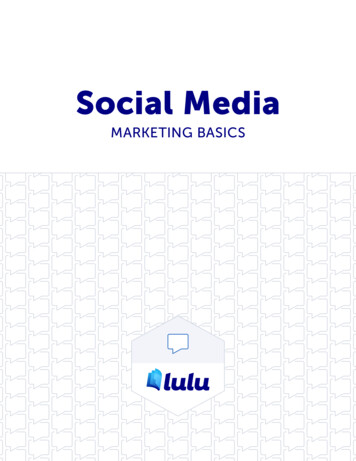
Transcription
Social MediaMARKETING BASICS
Copyright 2021 Lulu PressAll rights reservedThis work is licensed under the Creative CommonsAttribution-NonCommercial 4.0To view a copy of this license, 0/or send a letter to:Creative CommonsPO Box 1866Mountain View CA 94042USAlulu.com
According to a 2018 study, 77% of Americans and approximately2.34 billion people worldwide are on social media. That’s2,340,000,000-people posting, tweeting, liking, friending andpurchasing products across various social media platforms!If your marketing plan doesn’t incorporate some form of socialmedia, you’re likely missing a big portion of your audience.
Contents01 Social Media Platforms for Authors. 4FacebookTwitterLinkedInInstagramGoodreads02 Understanding Your Audience. 9Using the Right PlatformFinding Your Niche03 Snackable Content. 12Getting the Right ContentPosting CadenceThe Value of a Follow04 Appendix: Resources. 15Lulu Help Center and Knowledge BaseAdditional Resources
Social MediaPlatforms forAuthorsThere are hundreds of different social media platforms. From the widely knownFacebook, to the obscure (but growing) Vero.The first step is to determine which platform, or platforms, are right for you andyour author brand. Thankfully, your readers will largely be making this decisionfor you based on where they frequent. Even if you personally have a preferredsocial media platform, you are going to struggle to get any traction for yourauthor brand if your readers aren’t there.First step: find the platform your readers use.We have to make some assumptions about habits here, but the majority of readers are likely to be using the most common platforms. If you writeromance or thrillers, you’re going to find a lot of readers on Facebook. If you’rea business professional with a how-to book, LinkedIn is the place to be. Maybeyou’re more of a literary fiction author? You’re probably going to find morereaders on the Goodreads forums.Second step: build an author brand.For your social media presence, you need to determine whether or not you’llbe posting as yourself, or as you the author. For something like Goodreads,there really is no difference. But for Facebook, you should definitely considera Business Profile, especially if you’re going to try and sell books on their plat form. There’s a lot of specificity for each platform, so be sure to understandthoroughly how your chosen platform (or platforms) operate.Third step: bring on the contentYou’ll be posting regularly once you have your profile established. How oftenwill vary—for Twitter five or more posts a day is nothing. For Facebook, fiveposts are a lot. If you’re on Goodreads, you’ll be spending more time blogging and responding in long form, so the posts may be less frequent, but theresponses will pile up.SOCIAL MEDIA MARKETING BASICSSOCIAL MEDIA PLATFORMS FOR AUTHORS4
FacebookThe social media giant, Facebook attracts the broadest group of potentialreaders. If you’re writing in fiction genres, there’s a good chance you’ll findmultiple Facebook groups focused on your genre. This platform is a safe bet,but because it is so heavily trafficked, you can easily get lost in the “noise.”Facebook requires anyone using the platform for business to use a Page, not apersonal profile. One important thing to note: you need a Facebook profile inorder to create a Page. You can take your personal account and convert it to aPage, which Facebook can use to create a Page in addition to yourpersonal account.Your information will be transferred over to the Page and you will essentiallyhave a duplicate of your personal profile. However, for your author profile, it’ssmart to make a separate account. Make it different than your personal profileand give thought to your author brand and what you want to show the worldabout who you are and what they can expect from your work.Keep in mind that with a Page, you don’t need to friend people and wait forthem to accept your request to connect. Fans can just “Like” and “Follow” yourPage. And with a Page, you can have an unlimited number of Likes.Unlike your personal profile, a Page has analytics incorporated. This meansyou can measure posting performance (how well your post did relative toothers) in Facebook Insights. A major benefit includes tracking demographics. You can see if your cookbook is being seen by people who predominantlycook (ex. parents), or if your Sci-Fi epic is being seen by your target audience(ex. 18-45-year-old males). The demographic information allows you to targetyour ads better (if you’re running ads), helping you attract more new followers,who will become your new readers!Once you’ve started to gather information about your followers, you cancreate and monitor Facebook Ads with the Ads Manager. In general, they’rea great investment (when you can afford to invest), but not something youshould do without a fair amount of data to drive them. When investing inads, it’s important to remember that money you spend may not immediatelycome back to you with increased sales. Make sure you study up on the AdsManager first!SOCIAL MEDIA MARKETING BASICSSOCIAL MEDIA PLATFORMS FOR AUTHORS5
TwitterUnlike many other social media platforms, Twitter is almost entirely focusedon individuals. With that in mind, you’ll do best on Twitter if you have a significant following for yourself, rather than your content or works.The way you use Twitter to promote your author brand and your books will bea little more straight forward than Facebook. While you do have the option tocreate a separate profile specific to you as an author, there really isn’t a need.Twitter users want interactions with the individual, so it is best to be yourselfhere. And because Twitter happens so fast, you don’t have to worry as muchabout how often you post.To be successful on Twitter, you not only need to create quality posts andshare them consistently, but you also must engage actively with other users.Twitter demands that you seek out conversations and join them.Tweets are usually short and often get bluntly to the point. Users want to seethe newest tweets first and they often scroll toward newer content, whileFacebook creates a news feed more tailored to your interests and connections. Twitter happens (very nearly) in real time. If you want to be active onTwitter and use the tool to drum up new followers, you’ll have to spend sometime getting used to the platform and engaging with it for a set period oftime. Facebook is much more insular—you log on and scroll the page lookingat posts, commenting and liking here and there. With Twitter, the conversation can happen as a back and forth between users on the site much easierand faster.SOCIAL MEDIA MARKETING BASICSSOCIAL MEDIA PLATFORMS FOR AUTHORS6
LinkedInOften referred to as the Facebook for business professionals, LinkedIn isbecoming more and more of a content focused platform. That bodes well forauthors who create self-help, business strategy, or similar content. If your audience is primarily targeted at business professionals, LinkedIn is the platformfor you. Make sure to familiarize yourself with the layout and functionality ofLinkedIn before diving in and posting!In 2018, LinkedIn began to offer a simplified blogging tool, allowing users tocreate and share long-form content with their followers. This, along with theability to connect directly with business profiles, makes LinkedIn a truly uniquesocial media platform. It attempts to merge the scrolling/posting structure ofFacebook, with a content focus similar to a blog.What makes LinkedIn particularly useful for a business related self-publisher isthe ability to build a network around your professional connections. Findingand connecting with past coworkers and employers opens up new avenuesto reach potential readers. Or to land speaking engagements that furtherpromote your author brand.InstagramInstagram is different than any other social media platform, telling strictlyvisual stories. It’s best used to show off who you are, the face(s) behind yourbrand, company culture, and products!Instagram is also one of the fastest growing platforms. From September 2017to June 2018, their monthly active users grew by more than 25% to 1 billion.For comparison, Twitter is sitting at 336 million and Facebook had 2.19 billionmonthly active users in the first quarter of this year.If you’re an artist—be it photographer, painter, sculptor or any other visualcreator—you’ll find a lot of traction on Instagram. The platform’s focus onvisual sharing means you get to highlight your work while connecting with abroad and diverse audience.One powerful feature of Instagram is their Instagram Shopping, a way for businesses to tag products and create a storefront. Customers can easily shopproducts in posts and stories, all within the Instagram app. When it comes toselling your book, the more options for buying, the better right?SOCIAL MEDIA MARKETING BASICSSOCIAL MEDIA PLATFORMS FOR AUTHORS7
GoodreadsGoodreads is a bit of an outlier. It’s not exactly a social media platform in thetraditional sense, but because it is so focused on writers and readers, it bearsconsideration. Utilizing forum style groups and blogging, Goodreads can be apotent resource, but only if you have readers who use the platform.Goodreads is a great way to keep track of books you’ve read, leave reviews onthose books, and find new and interesting books based on what your followersare reading. As an author, Goodreads is quite powerful with a range of features. Giveaways – Goodreads giveaways are a great means to get your bookout there and in the hands of readers. A giveaway is an investment. Youare buying and supplying books at your own expense, but if those readersenjoy your book and leave positive reviews, you’ve bought a great deal ofuseful marketing at a relatively low cost. News and Reviews – The more reviews you have, the better. They don’teven need to be all positive, though of course you want as many positivereviews as possible. Each review is a step toward furthering your brand andencouraging new readers to try your book. More than other sites (evenAmazon), Goodreads is used to vet books, so the reviews you get here areparticularly valuable. Ask the Author – Goodreads allows for two kinds of profiles; a readerand an author. If you have an author account, readers (and other authors)can follow you. And if you’re being followed by another user, they canpost questions for you. Just like Twitter, the Ask the Author feature inGoodreads creates a direct line between you and the reader. This kind ofpersonal interaction can turn a potential reader into a true fan. They get toknow you, they get to inquire about why you twisted the plot this way, orwhy one of your characters acted that way.And the option to Ask the Author has a nice added bonus: any user whodoes so is directed to your author profile page. Now they see you, your information, and your catalog of available books.SOCIAL MEDIA MARKETING BASICSSOCIAL MEDIA PLATFORMS FOR AUTHORS8
UnderstandingYour AudienceNo one can deny social media’s impact on how we communicate. Though noteven a generation old, social media has already massively shifted our dialog,introduced us to new and interesting people from around the world, andopened the door to global marketing in ways previously unimaginable.From instant messaging (anyone remember AIM?) to Myspace, to the overwhelming dominance of Facebook and Twitter, social media has evolved agreat deal in a relatively short time. It’s connected us as never before andfostered a culture of connectivity and sharing.The trick to making the most of Social Media is a deep understanding of youraudience and what they want from their online experience.SOCIAL MEDIA MARKETING BASICSUNDERSTANDING YOUR AUDIENCE9
Using the Right PlatformHow do you choose? Just go with Facebook because you know it well? Switchto Instagram because the people who are interested in your books seem togravitate toward that platform?Accion, a nonprofit community lender funding entrepreneurs, offers thisgraphic that highlights the difference and purposes of social media platforms:source – AccionWhile their graphic is a good starting point, it oversimplifies to some degreethe differences. What matters most is where your readers are.And that is something you should be learning continually, even before youpublish and start selling. What social platforms do you use? What groups areyou part of? These are the people you’ve followed and interacted with whilecreating your book, so of course they will want to be your first source forpotential customers.SOCIAL MEDIA MARKETING BASICSUNDERSTANDING YOUR AUDIENCE10
Finding Your NicheOften times, niche can be confused with audience. They are different in thecontext of marketing your book.Your audience are the people you are marketing too, but your niche is thegenre or category you’re marketing within. You might better think of theniche as the loose group of other books and authors your competing against,though that isn’t a perfect analogy.Understanding your niche is critical in social marketing because it will help youdefine your goals.For example, if you write thrillers, you’ll have a large niche full of similar authors.So, your social media goal will be focused on getting followers (you’ll likely beusing Facebook and Goodreads as your main platforms). Once you start tobuild followers, you’ll want reviews on the sales you have, which will reinforceyour value (and your book’s quality) above other books in your genre.Conversely, if you create coloring books, your niche will be broader but not aspopulated. You’ll probably be focusing on Instagram and making sales, sinceyou don’t need tons of reviews to push a product like coloring books.SOCIAL MEDIA MARKETING BASICSUNDERSTANDING YOUR AUDIENCE11
SnackableContentSnackable content is one of those marketing professional catch phrases.The kind of thing you might hear at a marketing conference or see on somemarketing guru’s blog.It basically means content that is easy and fun to consume with little effortfrom the consumer. Like a snack.Getting the Right ContentJust posting something for the sake of making a post is a terrible idea. You’llbe wasting your time making a post that most (if not all) of your followerswill ignore.Now, you can’t honestly expect all of your posts to be amazing and eyecatching. But you should aim to make every post have value and at least thepotential to grab the attention of some of your readers. That means creatingand sharing the right content.Of course, the right content is vague. Because there are so many variables.The kind of book you’re offering, the niche you fit in, the social media presenceyou’ve already cultivated, the quantity of followers you have, and many more.SOCIAL MEDIA MARKETING BASICSSNACKABLE CONTENT12
Luckily, there are a few guidelines that can help start your content:1. Keep it simple and direct – No matter what social platform you’reusing, keep your posts short and to the point. Unless you’re penning a fullblog post (which differs from a social media post) you need to give yourfollowers just the most important information in a few words, an image,and a link to learn more if they desire.2. Post regularly but don’t over post – Give your followers consistentcontent, but don’t post so much that your social media presence is overloaded with content. If you do post too much, invariably the quality willdecrease and you’ll be doing more work than you need.3. Carefully vet your shares – One awesome way to add content is toshare an article, meme, or post someone else made that you like or agreewith. Just be sure to carefully review this content for accuracy beforesharing!Posting CadenceJust how often should you post?There are plenty of guides. Three times a day is common for a business onFacebook. But you could easily do three to five a week as an individual author.What is important is that you maintain a consistent and regular cadence. If onepost a day makes sense for your schedule and goals, stick to that. One post,every day.Also, you need to be sure to post in the manner your preferred platformfocuses on the most. That means responding to comments and engaging inconversation if you use Twitter, starting and engaging in forum discussions onGoodreads, and posting image-rich, hash tagged content on Instagram.There is no perfect formula for your posting regularity, but the critical thingto keep in mind is consistency. Try to prepare your posts ahead of time andschedule them to post at the same time each day, with the same regularity.Additionally, try to use insights and data, whenever available, to optimize yourcontent choices and posting times.SOCIAL MEDIA MARKETING BASICSSNACKABLE CONTENT13
The Value of a FollowWhen you make a sale, there is a tangible value to that action. A dollar amountyou can easily quantify.And when you capture an email there is something tangible (the user’s emailaddress) that has a measurable value because you now have direct and intimate access to their inbox.Social media “follows” do not have as easily quantified metrics. How much is aFollow or Like worth to you and your author brand?Fortunately for you and all entrepreneurs working to build their platform andmake a living doing the things they love; social media is continually introducing new ways to monetize your follower list. Facebook and Instagram bothoffer a marketplace. Goodreads is tied directly to Amazon for the purposes ofbook listing.With the growth in social media as a marketplace and ecommerce tool, thevalue and worth of followers will continue to grow. Their value is different thanan email address because you cannot hope that all of your followers will seeyour posts. But because social media algorithms push content to their usersbased on those user’s likes and interests, more of the people who see yourcontent on social media will be those most likely to be interested, and ideallyto make a purchase.SOCIAL MEDIA MARKETING BASICSSNACKABLE CONTENT14
Appendix:ResourcesLulu Help Center and Knowledge BaseLulu's Help Center features resources to help you publish your book.Visit the Lulu Help Center to learn more.Additional ResourcesLulu Blog: Let's Get SocialMoz: Social MediaSocial Media Examiner: Getting Started With Social MediaSOCIAL MEDIA MARKETING BASICSAPPENDIX: RESOURCES15
useful marketing at a relatively low cost. News and Reviews – The more reviews you have, the better. They don’t even need to be all positive, though of course you want as many positive reviews as possible. Each review is a step toward furthering your brand and encouraging new readers to tr


